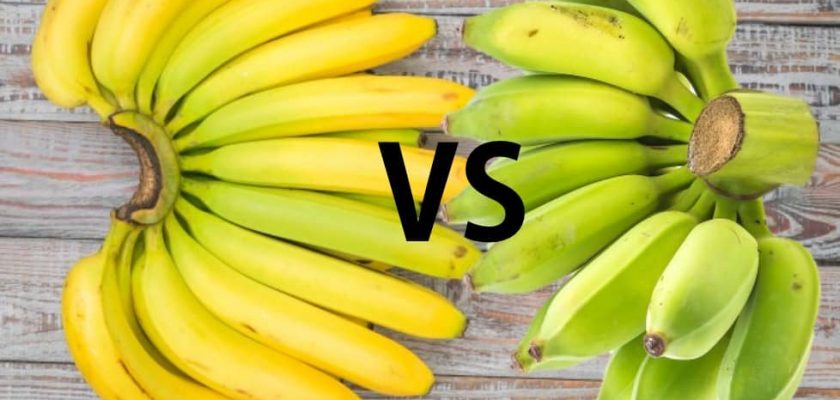I love Bananas are tasty to eat, but some don’t because of the texture and the taste. But lately, there are many people asking the same question, which banana (yellow) or (green) bananas are better for your health and which banana contains what minerals and vitamins? Isn’t that strange?
We all while growing up have been told to eat a yellow banana as it is ripe and tastes good. But in fact, even green banana (unripe) is good to eat it has its own benefits.
Let’s take a closer look at which bananas are good for you and what are their benefits.
The benefit of eating Yellow (ripe) Banana
There are levels of ripeness starting from 1-15, where 1 is being the most underripe and 15 overripe. A yellow ripe mushy banana has lots of nutrients content in it, it contains vitamins, potassium, manganese and most importantly fiber. If you eat it you will consume a lot of amount antioxidants which indirectly help you lower your aging problem.
There was news that the banana has cured a cancer patient. And a research paper where it has a report on how vegetables and fruits reduce the risk of getting kidney cancer and whereas banana has shown maximum results.
If you consume overripe banana you will not have any digestion issues.
And if you consume brown a fully grown banana you will get a good amount of antioxidants as the starchy textured converts into direct sugar.
Now the liking taste and texture are your personal factors where you like it or not. A ripe banana is always sweet to taste.
Drawbacks about ripe Yellow banana
Now, when a banana gets ripe more and more it starts losing its nutrients. And also a diabetic person should avoid consumption of ripe banana as it has a high amount of sugar content and a ripest banana contains a high amount of glycemic index too.
The benefit of eating green (unripe) Banana
These types of bananas are not so ripe. They are only ¾ stage of their ripeness as they are yet to reach the retailers, and it takes time to reach till them. So they are sold before they get very ripe.
As it contains starch after consumption of these green bananas you will feel full. These green bananas are not ripe yet and as you know the ripen bananas contains starch which turns to sugar and so who is having a high cannot eat the regular ones, so consumption of these green bananas can be worthy to these guys.
Drawbacks of eating green bananas
As they are not ripe and green they don’t have a good taste, and if you don’t eat a yellow banana you may not like to eat green. And the green bananas may not give you vitamins, antioxidants as compared to ripe yellow banana.
It contains latex, so if you are allergic to it then don’t eat a green banana.
Also, it may give you gases, constipation and can be hard to digest, so be careful.
Both the bananas are nutrients based
Both green and yellow bananas are good nutrients based, they contain some equal amount of nutrients
- Fiber: 3.1 grams
- Potassium: 12% of the RDI
- Vitamin B6: 20% of the RDI
- Vitamin C: 17% of the RDI
- Magnesium: 8% of the RDI
- Copper: 5% of the RDI
- Manganese: 15% of the RDI
The total adds up-to 105 calories, where 90% is carbs and low fats.
Benefits of eating bananas
Bananas contain nutrients that lower the levels of blood sugar so it’s not advisable for a diabetic person to eat a ripened banana and if they consume by mistake then they should monitor their blood sugar.
A banana is a good source of fiber, and it helps and improves your digestion
Bananas can help to lose weight – A banana is nutritious and has more than 100 calories. But no one has ever experimented consuming bananas reduces their weight
Potassium – a rich mineral source that controls your blood pressure, which is good for the heart.
Magnesium – It also contains magnesium which is also good for the heart
Bananas have a good source of dietary antioxidants and it reduces heart disease and degenerative illness.
A green banana has an excessive level of starch content and whereas yellow banana contains lower starch content.
Unripe bananas are a major source of resistant starch, which may enhance insulin sensitivity.
A study reveals those who consume 2-3 bananas on a daily basis likely to develop 33% less kidney disease.
An athletic food banana it is always said and consumed by sports personalities as it contains minerals and easily digested carbs. And it also gives relieve your cramps.
Good snack food you can add in your yogurt, smoothies & cereal, it can be used as sugar in baking or cooking too.
How many calories are there in a banana with different sizes?
- Extra small (less than 6 inches, 81 grams): 72 calories.
- Small (6–7 inches, 101 grams): 90 calories.
- Medium (7–8 inches, 118 grams): 105 calories.
- Large (8–9 inches, 136 grams): 121 calories.
- Extra large (9 inches or longer, 152 grams): 135 calories.
- Sliced (1 cup, 150 grams): 134 calories.
- Mashed (1 cup, 225 grams): 200 calories.
An Average banana size contains about 100% calories.
93% of banana contains carbs, 4% from protein and 3% from fat.
How many Carbs are there in a banana with different sizes
- Extra small (less than 6 inches, 81 grams): 19 grams.
- Small (6–7 inches, 101 grams): 23 grams.
- Medium (7–8 inches, 118 grams): 27 grams.
- Large (8–9 inches, 136 grams): 31 grams.
- Extra large (9 inches or longer, 152 grams): 35 grams.
- Sliced (1 cup, 150 grams): 34 grams.
- Mashed (1 cup, 225 grams): 51 grams.
An average-sized banana contains about 25 grams of carbs, perhaps even less if the bananas are unripe (green)
So which banana you are going to eat?
So, yes bananas are good for your health and they both have their own benefits and drawbacks. And if you don’t mind the taste then you can eat a green banana and if you really eat it for the taste then you should eat a yellow banana. But in fact, you should consume both as they have the same amount of calories.
Read article – Is Peanut Butter Ketogenic? Powerful Carbs to Calories

